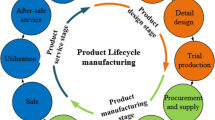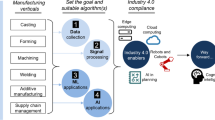Abstract
Assembly planning attempts to arrange product assembly sequences on the basis of the input of product description, similar assembly plans and assembly constraints. Assembly planning is frequently viewed as a creative thinking process, which requires extensive assembly planning experience. Assembly product modeling with mechanical connection functions has increasingly focused on assembly sequence planning. When considering the connection functions, the relationships between assembled components can act as a foundation for assembly clustering. Despite the merits of assembly sequence planning in lieu of considering connection functions, previous investigations have focused primarily on product representation with the connector concept. However, to our knowledge, generation of the assembly sequence on the basis of the connector concept has not been previously discussed. In this study, we present a novel means of generating assembly sequences on the basis of the connector concept. The proposed method initially defines different types of connectors and representation schemes. Through the definition and representation scheme, an assembly product can be decomposed into a set of connector-based assembly elements. The connector-based assembly elements then serve as input for an assembly sequence generation algorithm, which is connector-based, to generate an assembly sequence. The final output is a connector-based assembly sequence graph, resembling an assembly precedence diagram. In addition, this graph can act as the input for any line balance method when designing work elements for each assembly workstation.
Similar content being viewed by others
References
Akagi, F., Osaki, H. and Kikuchi, S. (1980) The method of analysis of assembly work based on the fastener method. Bulletin of the JSME, 23(184), 1670–1675.
Bedworth, D. D., Henderson, M. R. and Wolfe, P. M. (1991) Computer-Integrated Design and Manufacturing, McGraw-Hill, Inc. New York
Boothroyd, G., Dewhurst, P. and Knight, W. (1994) Product design for manufacturing and assembly, Marcel Dekker, inc.
Gu, P. and Norrie, D. H. (1995) Intelligent manaufacturing planning, Chapman & Hall, London.
Gui, J. K. and Mäntylä, M. (1994) Functional understanding of assembly modeling. Computer-Aided Design, 26(6), 435–451.
Johnson, A. L. (1991) Designing by function. Design Studies, 12(1), 51–57.
Ko, H. and Lee, K. (1987) Automatic assembling procedure generation from mating conditions. Computer-Aided Design, 19(1), 3–10.
Kusiak, A. editor (1993) Concurrent engineering: automation, tools and techniques, John Wiley & Sons, New York.
Libardi, E. C., Dixon, J. R. and Simomons, M. K. (1988) Computer environments for the design of mechanical assemblies: aresearch review. Engineering with Computers, 3, 121–136.
Lyengar, G., Lee, C. L. and Kota, S. (1994) Toward an Objective Evaluation of Alternate Designs. Transtraction of the ASME Journal of Mechanical Design, 116, 487–492.
Nevins, J. L. and Whitney, D. H. (1989) Concurrent design of product and processes:a strategy for the next generation manufacturing, McGraw-Hill, New York.
Nnaji, B. O., Jagtap, P. B., Sadrach, J. B. and Yeh, S. C. (1992) Automatic precedence and spanning vector generation for assembly planning. Journal of Design and Manufacturing, 2, 211–224.
Nnaji, B. O. (1993) Theory of Automatic Robot Assembly and Programming, Chapman & Hall, London.
Oliver, J. H. and Hung, H-T (1994) Automated path planning for integrated assembly design. Computer-Aided Design, 26(9), 658–666.
Sekiguchi, H., Kojima, T., Inous, K. and Honda, T. (1983) Study on automatic determination of assembly sequence. Annuals of the CIRP, 32(1), 21–28.
Shigley, J. E. and Mischke, C. R. (1988) Mechanical engineering design 5th edition, Mcgraw-Hill, New York.
Stoll, H. W. (1988) Design for manufacturing. Manufacturing Engineering, 67–73.
Suh, N. P. (1997) Design of systems. Annals of the CIRP, 46(1), 75–80.
Subramani, A. K. and Dewhurst, P. (1991) Automatic generation of product disassembly sequences. Annuals of the CIRP, 40(1), 115–118.
Wang, H. P. and Li, J. K. (1991) Computer-Aided Process Planning, Elsevier Science Publishers B.V.
Zhang, H. C. and Alting, L. (1994) Computerized manufacturing process planning system, Chapman & Hall, London.
Author information
Authors and Affiliations
Rights and permissions
About this article
Cite this article
Tseng, HE., Li, RK. A novel means of generating assembly sequences using the connector concept. Journal of Intelligent Manufacturing 10, 423–435 (1999). https://doi.org/10.1023/A:1008971030395
Issue Date:
DOI: https://doi.org/10.1023/A:1008971030395




